Sharing Disabled Lives and Stories Onstage
An Interview with Luda Lee
BY EMMALY WIEDERHOLT
Translated by Soo Jung Bae
Photos by Sanghoon Ok and courtesy Luda Lee
한글로 인터뷰를 읽으시길 원하신다면 스크롤을 내려주세요.
Luda Lee is the choreographer and director of Black Toe Dance Company in Seoul, South Korea. She uses her background in ballet and contemporary dance to address social issues through her choreography. At the Korea International Accessible Dance Festival (KIADA) in November 2022, her piece Trialogue explored the stories of three dancers with disabilities. Here, Luda Lee shares her trajectory of becoming a choreographer and the inspiration behind some of her pieces. She also details the process of making Trialogue and how it informed her personal perspective on disability.
This interview is part of a series of interviews with presenters and performers at KIADA 2022.
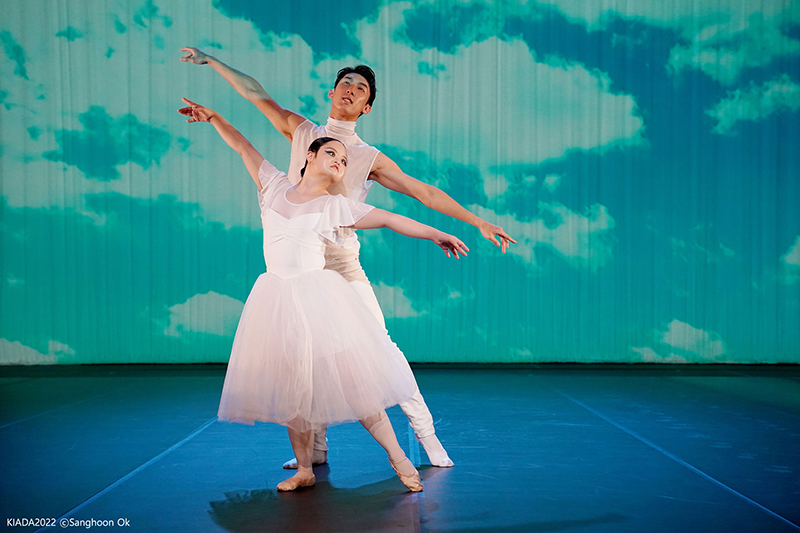
~~
Can you share a little about your dance history and what shaped who you are as an artist?
I started dancing when I was four. My mother was a dancer and she recommended I learn dance. I majored in ballet at Sunhwa Arts School and Korea National University of Arts.
When I was a member of Universal Ballet Company, I wanted to find new movements. So I moved to New York. In New York, I encountered contemporary ballet, contemporary dance, and improvisation. I experienced diverse genres of dance. Korean ballet education was heavily influenced by Russia. So for me, American ballet was like a whole new world. I was interested in George Balanchine and the New York City Ballet, so I premiered Stars and Stripes, choreographed by Balanchine, for my college graduation piece. In New York, I debuted choreography with the theme black. After that, the time I spent in New York dancing and performing was an opportunity for me to find my own unique color, where I broke free of the standards of classic ballet.
When I came back to Korea, I participated in a dance survival TV show named Dancing 9. I won the final championship and made a name for myself with my piece Black Swan. Then I founded Black Toe Dance Company and have led the dance company for 10 years. I have a heavy influence from my mother Lee Jung Hee, who is a first-generation dancer of Korean post- modern dance. She inspires me to create. She is my role model. She motivates me and gives me sharp advice, so I learn a lot from her. I want to become an artist who has an exceptional and undying enthusiasm just like her.
How would you generally describe your choreography to someone unfamiliar with it?
When I founded Black Toe Dance Company in 2013, I was determined to make ballet more popular, so I painted the pink ballet shoes black.
Black Toe Dance Company strives to create pieces that deal with contemporary social issues, injustice of human society, and human life and instincts. For example, in the Black Swan Lake series, we reinterpreted Swan Lake in the eyes of the black swan. In W, we expressed the life of a woman by arranging The Rite of Spring by Stravinsky. The Dystopia series dealt with the environment and human extinction. Half And Half portrayed the lives of performers with sincere scripts and dance. And there’s also Trialogue.
Recently, we are expanding our movement without distinguishing between ballet, contemporary dance, and street dance.
How did you get involved with or introduced to KIADA?
On the Day of the Disabled in Korea (April 20th) of 2021, I participated in an event held by the National Korean Broadcasting company, KBS. There I came across disabled artists and was deeply moved. After that, someone recommended that I apply to KIADA, so I created Trialogue and it was selected.
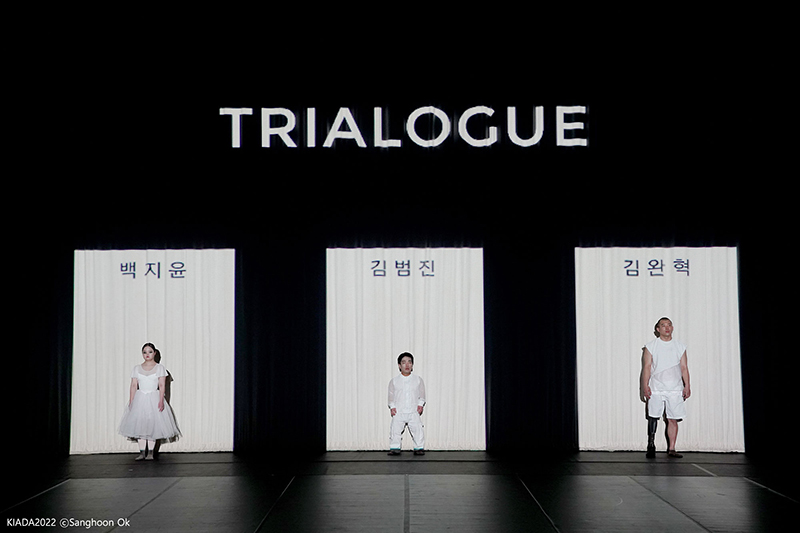
Can you share some information about Trialogue, the piece you created for KIADA 2022? What was the impetus behind the piece?
Just like the name Trialogue suggests, it’s a story of three people: ballerina Ji Yoon Baek (who has an intellectual disability), actor Bum Jin Kim (who has a physical disability), and B-boy Wan Hyuk Kim (who has a physical disability). I met Ji Yoon Baek through an institution. In the case of Bum Jin Kim and Wan Hyuk Kim, I sent a message through Instagram and cast them myself. Luckily, they all agreed to participate in the piece.
I needed some time to get to know them. So before working on the choreography, I did several interviews. The more I spoke to them, the more I felt that the life they lived was magnificent. I wanted the audience to see and feel their lives and their stories. I tried to put on stage the times they have been challenged, while believing in the possibility of dance and fully embracing their limitations. After summarizing the interviews, we made them into scripts, recorded the scripts with dancers’ voices, and combined them with music. We also formed a scene where the dancers danced with non-disabled dancers to express that we are all the same with just a little bit of difference.
Most of all, I wanted to portray the dance life of the three dancers. They face thick walls of prejudice built by society, and they have overcome their mental and physical limitations. And with that strong will, they found the meaning of their unique lives. I wanted to show how they beautifully exist through dance.
At first, we were quite careful when we did interviews. But the three dancers opened up and told me about their stories. I truly thank the three dancers who wholeheartedly performed in this piece.
What was your choreographic process creating the piece?
I thought of visualizing the stories of the three dancers into a space. I used video mapping with a beam projector to divide the background video as if they were in three rooms. And then we made the scripts into subtitles in both Korean and English and also worked on sign language. I created each scene by using a metaphor of mother nature with each dancers’ story. Just like a swan flapping its wings, if you keep on flapping you could fly into the sky. Ji Yoon’s room was projected with such an image. Bum Jin’s room was portrayed with an image that implies one has immense dreams although one’s body is small. Wan Hyuk’s room was portrayed with an image of a desert turning into a forest. It was to imply that it was a cruel reality to even stand on the ground, for one who has lost a leg in an accident.
Alongside the three main dancers, there were three non-disabled dancers: ballet dancer Lee Woo Sun, contemporary dancer Rho Jung Woo, and my sibling Lee Ru Ma who was partly in charge of choreography. They were considerate with the disabled dancers. Watching them harmonizing with the disabled dancers, I was deeply touched; sometimes in the middle of practice I burst into tears. Trialogue starts with a scene where three main dancers are standing in each of their rooms. Then they partner with the non-disabled dancers to Wonderful World by Louis Armstrong. And when they return to their rooms, they are not alone anymore. They ended the scene with a partner, and for me this scene was the most memorable part. It deeply touched me. For me, what I learned from this project was harmony. Everyone has a different body, different experiences, and different scars. But we see each other and understand each other to become one on the stage. Honestly, I cried next to the stage on the day of the show. I want to thank Hyong Song Hee, who helped with the interviews and scripts, all the performers, and the staff of KIADA.
From your perspective, what opportunities are there for dancers with disabilities in your community?
I think there are attempts being made to try a variety of dance education in Korea. It seems like there are dance companies with disabled dancers. There also seem to be performances based on education.
I have one thing that I feel bad about though. Normally the leading dancers are non-disabled. I understand how the disabled dancers sometimes need guides. But I felt bad about how the disabled dancers stand behind the non-disabled dancers.
That’s why I strongly felt the need to make the disabled dancers the main characters of this KIADA performance. And I think the performance was formed based on appropriate balance with the support of the non-disabled dancers.
How would you like to grow or expand your work in the future?
I have a lot of projects I want to try. I learned a lot from KIADA and I want to create pieces that genuinely put life on the stage. I also believe I need to work on business for Black Toe Dance Company, to continue its work with a unique identity. I have to focus on creating a stable system and environment. 2023 is the 10th anniversary of the company so I’m planning on having a celebratory event, where we look back on the time we grew together while watching performance videos and also showing our repertory. From now on, for the next ten years, I want to work on meeting more audiences and communicating with more audiences by popularizing and expanding my work. For that to happen, I need to try collaborating with other fields to create online content and dance films. Most of all, I want to become a great leader and a good person for colleagues to trust me. I think dance is an art that gives and receives good energy between people, so I believe that I first need to become a good person for there to be good people around me. I want to grow together with good people.
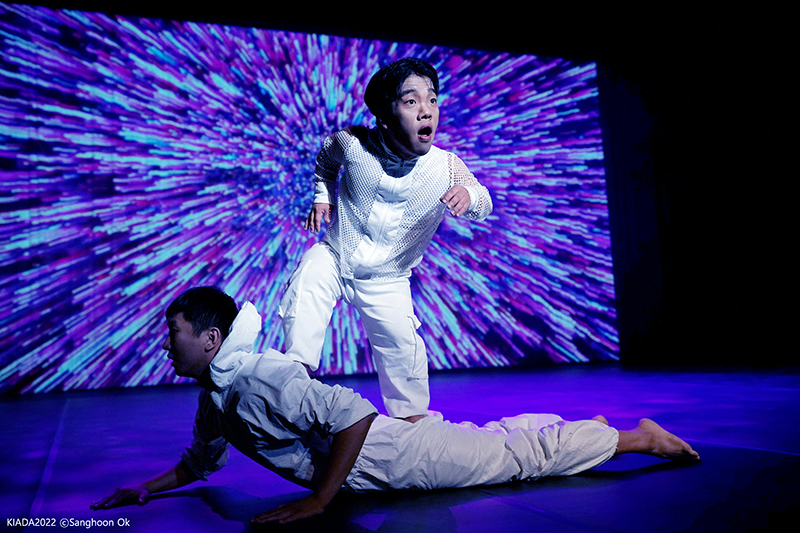
~~
장애인들의 삶과 이야기를 무대로 나누다
이루다 안무가 인터뷰
에말리 위더홀트(Emmaly Wiederholt) 작성
배수정 번역
사진 촬영: 옥상훈
이루다 안무가는 서울을 기반으로 한 무용단 블랙토 댄스 컴퍼니의 감독이자 안무가입니다. 그녀는 발레와 현대 무용을 전공한 것을 바탕으로 사회 문제를 다루는 안무를 만듭니다. 2022년 11월에 개최된 대한민국장애인국제무용제 (KIADA)에 올려진 그녀의 작품 <세 사람의 이야기>에서는 장애를 가진 세 무용수의 이야기가 펼쳐집니다. 본 인터뷰에는 이루다 안무가가 안무가가 된 과정과 그녀의 작품들의 탄생 계기가 실려 있습니다. 세 사람의 이야기를 만든 과정과 이것이 장애에 대한 그녀의 관점에 어떤 영향을 주었는지도 서술되어 있습니다.
본 인터뷰는 키아다 2022에서 공연을 한 무용수들과 안무가들의 인터뷰 모음집의 일부입니다.
~~
과거에 어떤 무용을 해오셨는지, 어떻게 무용을 하게 되셨는지 경험들에 대해 말씀해주실 수 있나요? 또, 예술가가 되는 것에 영향을 미쳤던 것이 있다면 무엇이었나요?
저는 무용가 어머니의 권유로 4살때부터 발레를 배웠고 선화예술학교와 한국예술종합학교에서 발레를 전공하였습니다.
유니버설 발레단에서 단원 생활을 하던 중 새로운 움직임을 찾고자 뉴욕으로 떠났고 그곳에서 컨템포러리 발레와 현대무용, 즉흥무용을 접하며 다양한 장르의 춤을 경험했습니다. 한국의 발레교육은 러시아의 영향을 많이 받았기에 저에게 미국 발레는 신세계였습니다. New York City Ballet의 ‘George Balanchine’ 작품에 관심이 많았었기 때문에 대학졸업작품에도 Balanchine 이 안무한 ’Stars And Stripes’ 작품을 한국에서 최초로 초연하였습니다. 뉴욕 Dumbo에서 Black을 주제로 안무 데뷔했고 그 이후에도 Neo-classic이나 contemporary ballet작품을 안무해왔습니다. 뉴욕에서 춤추고 공연했던 시간들은 제가 갇혀 있던 클래식 발레의 기준을 깨뜨리고 저만의 색깔을 찾게 해준 뜻깊은 시간들이었습니다. 한국에 돌아와서는 TV Show 댄스 서바이벌 ‘댄싱9’ 에서 최종우승팀으로 출연하여 저만의 Black Swan으로 이름을 알렸고, 그 이후 ‘Black Toe Dance Company’를 창단하여 10년간 무용단체를 이끌고 있습니다.
제가 계속해서 창작욕구를 불태울 수 있는 것은 한국 포스트모던댄스 1세대 무용가이신 어머니(이정희)의 영향이 가장 큽니다.
항상 곁에서 귀감이 되어 주시고 거침없이 날카로운 조언으로 저에게 좋은 자극을 주셔서 어머니를 통해 배우고 깨닫는 것이 가장 많습니다.
앞으로 어머니처럼 독보적이고 식지 않는 열정으로 깨어 있는 예술가가 되고 싶습니다.
선생님의 무용·안무에 대해 잘 모르는 사람들을 위해서 선생님의 무용을 알려주신다면, 대략 어떻게 설명해주실 수 있나요?
2013년에 창단한 ‘Black Toe Dance Company’는 새롭고 대중적인 발레를 만들어가겠다는 의지로 핑크빛 발레슈즈를 검게 칠하면서 시작되었습니다.
‘Black Toe Dance Company’는 클래식 발레 백조의 호수를 흑조의 시선으로 재해석했던 <Black Swan Lake> 시리즈, Stravinsky의 봄의 제전 음악을 편곡하여 여성의 삶을 표현했던 <W>, 환경문제와 인류멸망을 다룬 <디스토피아> 시리즈, 출연자의 삶을 진솔한 대사와 춤으로 풀어내는 <반반(Half And Half)>, <세 사람의 이야기(Trialogue)> 등 10여년간 인간의 삶과 본능, 인간사회의 부조리, 동시대적 사회문제를 감각적이고 대중적으로 작품화 하려고 노력해왔습니다.
최근에는 발레와 현대무용, 스트릿 댄스의 구분 없이 다양한 무용수들과의 움직임으로 확장하여 새로운 작업들을 이어가고 있습니다.
키아다를 어떻게 소개받게 되었나요? 혹은 어떻게 키아다와 함께 하게 되었나요?
2021년 한국공영방송 KBS 장애인의 날에 행사에 참여하면서 장애를 가진 예술인분들을 직접 보게 되었고 큰 감동을 받았습니다. 그 이후 키아다 공모에 신청해보라는 추천을 받았고 <세 사람의 이야기>를 구상하여 국내 초청작으로 선정되었습니다.
올해 키아다에 올려진 선생님의 작품 <세 사람의 이야기>에 대해 조금 설명을 해주실 수 있나요? 작품의 탄생에 영향을 준 계기나 동기가 있을까요?
제목 그대로 지적장애를 갖고 있는 백지윤 발레리나, 지체장애를 갖고 있는 김범진 배우, 지체장애를 갖고 있는 김완혁 비보이 <세 사람의 이야기(Trialogue)> 입니다. 백지윤씨는 주최측의 소개로 만났고 김범진씨와 김완혁씨는 제가 직접 인스타그램 다이렉트 메세지로 섭외했습니다. 다행히도 흔쾌히 출연에 응해 주셨고 저는 세 사람을 알아가는 과정이 필요했습니다.
그래서 안무에 들어가기 전에 인터뷰를 여러 차례 진행했고 대화를 나눌수록 그들의 지나온 시간들이 정말 위대하다고 느껴졌기에 관객들도 세 사람의 삶과 이야기들을 있는 그대로 보고 느꼈으면 좋겠다고 생각했습니다. 장애를 극복하고 춤을 춰온 3명의 댄서들이 자신의 한계를 온전히 포용하며 춤 속 가능성을 믿었던 그들의 값진 도전의 시간들을 무대 위에 잘 담으려고 노력했습니다. 인터뷰 내용을 축약해서 대본을 만들어 그들의 목소리로 대사를 녹음하여 음악적 사운드와 조합하였고 비장애인 파트너와 함께 춤추는 장면도 구성하여 우리는 조금 다를 뿐 모두 같은 인간이라는 것을 표현하고자 했습니다.
무엇보다 세상이 두껍게 쌓아 올린 편견의 벽과 부딪히며 정신적, 신체적 한계를 넘어서는 그 의지로 자신만의 삶의 의미를 발견해온 세 명의 춤 인생과 춤을 통해 자기 극복의 힘으로 오롯이 아름답게 존재한다는 의미를 잘 전달하고 싶었습니다.
사실 처음에는 인터뷰가 조심스러웠는데 자신의 이야기를 스스럼없이 꺼내 주시고 적극적으로 작품에 참여해주신 세 분께 진심으로 감사드립니다.
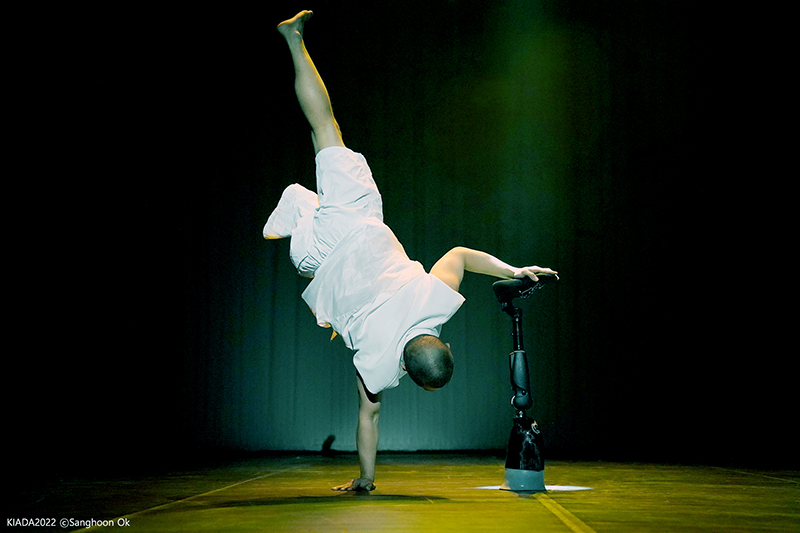
작품을 만드시는 과정이 어땠는지 설명해주실 수 있을까요?
저는 세 분의 이야기를 시각적인 공간으로 설정해야겠다고 생각했고, 빔프로젝터로 영상 맵핑을 활용하여 각자의 방처럼 배경영상을 분할하고 청각장애인들을 위해 모든 대사들을 한글과 영문으로 자막표기 하면서 수어 동작을 동작화 하였습니다. 백조처럼 날갯짓을 하다 보면 하늘위로 날아갈 수 있을 것 같다는 백지윤씨의 방은 하늘이 비추고, 몸이 유독 작지만 그 누구보다 광활한 꿈을 꾼다는 김범진씨의 방은 우주가 비춰지며, 사고로 한쪽 다리를 잃어 땅 위에 발을 딛고 서는 것조차 척박한 현실이었다는 김완혁씨의 방은 사막에서 숲으로 바뀌는 등 그들의 이야기를 우주만물과 대자연에 빗대어 장면을 구성하였습니다.
너무나 고귀했던 주인공 세 사람의 진정성뿐만 아니라 함께 참여해준 비장애인 무용수 발레리노 이우선, 현대무용가 노정우 그리고 조안무를 맡아준 제 친동생 이루마의 장애인 무용수들을 위한 배려와 균형을 맞추려는 아름다운 모습을 보며 감동할 수밖에 없었고 주책 맞게도 연습 중에 혼자 감동해서 자주 눈물을 흘리곤 했습니다. 주인공 세 사람이 영상 맵핑으로 만들어진 3개의 방에 한 명씩 혼자 서있는 장면으로 작품이 시작되지만 비장애인 파트너와 커플이 되어 Louis Armstrong의 Wonderful World노래에 맞춰 함께 춤을 추고 다시 3개의 방으로 들어갔을 때는 혼자가 아닌 파트너와 마지막 포즈로 마무리하였는데 저는 개인적으로 마지막 장면이 가장 인상적으로 기억에 남습니다. 저에게 이번 작업의 가장 큰 배움은 ‘조화’ 였던 것 같습니다. 모두 각기 다른 신체와, 경험과, 상처를 가진 무용수들이 서로를 이해하고 스스로를 인정하며 무대위에서 구분없이 하나가 되었음을 보았습니다. 그래서인지 본 공연 때 저는 무대 옆에서 소리 죽여 통곡했습니다.^^ 큰 감동을 주신 출연자 분들과 인터뷰 및 대본에 도움주신 형송희님 그리고 키아다 스탭분들께 진심으로 감사드립니다.
선생님이 보시기에, 선생님이 속한 공동체에는 장애를 가진 무용수들에게 어떤 기회가 주어지나요?
국내에서도 장애인을 위한 무용교육이 다양한 프로그램으로 시도되고 있는 것 같습니다.
교육을 바탕으로 발표회 개념의 공연들이 주기적으로 이루어지고 장애인 무용수가 소속된 무용단체도 꽤 있는 것 같습니다.
한 가지 아쉬운 점은 주로 작품을 이끌어가는 출연자는 비장애인인 경우가 많은데, 장애를 가진 무용수가 무대위에서 동작을 잊어버리거나 당황하는 상황을 대비해서 동작시범과 리더가 필요할 수밖에 없겠지만, 저는 개인적으로 비장애인 무용수 뒤에 장애 무용수가 서있는 모습이 한편으론 안타까웠습니다.
그래서 저는 이번 키아다 <세 사람의 이야기>에서 반드시 장애를 가진 무용수가 주인공인 무대를 만들어야겠다고 다짐했고 비장애인 무용수들의 서포트로 적절한 균형의 작품으로 구성된 것 같습니다.
선생님께서는 미래에 선생님의 작업을 어떻게 확장하고 또 성장시키고 싶으신가요?
앞으로 하고 싶은 작업이 정말 많습니다. 일단 이번 키아다를 통해 많이 배우고 느낀만큼, 계속해서 삶과 인생을 진솔하게 무대 위에 올리고 싶은 마음이 크고 제가 이끌고 있는 ‘Black Toe Dance Company’ 가 뚜렷한 정체성을 가지고 작품 활동을 이어갈 수 있도록 안정적인 무용단 시스템과 환경을 만들어 경영에도 힘써야 한다고 생각합니다. 2023년이 창단 10주년이 되는 해라, 무용단이 성장해온 시간들과 공연자료들을 되돌아보면서 상영회 같은 기념행사와 레퍼토리 공연을 기획 중에 있습니다. 앞으로의 10년은 더 많은 관객을 만나 소통할 수 있도록 저변확대와 대중화를 위해 힘쓰고 싶습니다. 그러기 위해서는 다른 분야와 협업하면서 온라인 콘텐츠 개발과 댄스필름 제작 등 다양한 시도가 필요할 것 같습니다. 무엇보다 저를 믿어준 동료들의 기대에 부응할 수 있는 훌륭한 리더이자 좋은 사람이고 싶습니다. 무용은 사람과 사람의 기운을 주고 받는 예술이라 제가 먼저 좋은 사람이 되어야 제 곁에 좋은 사람들이 함께 할거라는 믿음이 있기에 앞으로 좋은 사람들과 함께 성장하겠습니다.
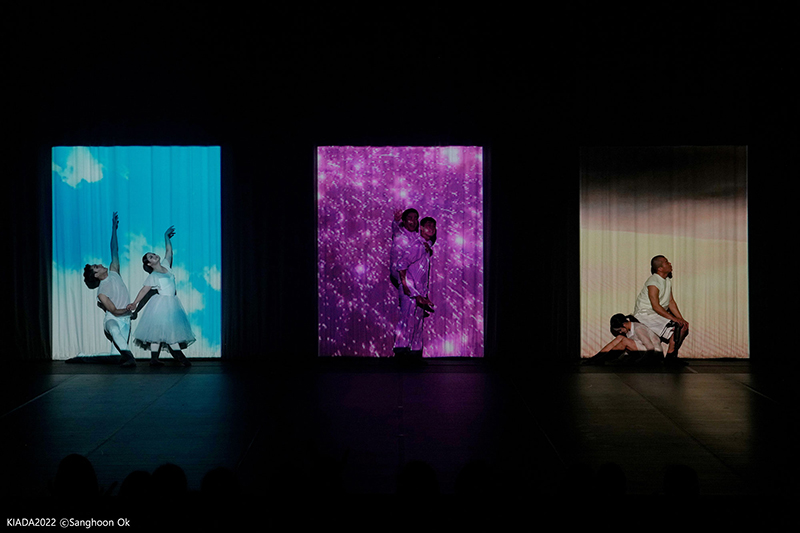
~~
